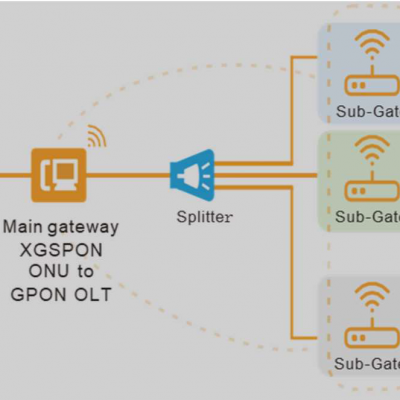A low-cost, compact PON OLT integrated on an FPGA SoC, offering support for GPON in applications such as FTTR
The Markets and Challenges
Broadband customers are becoming more concerned about reliability and performance than price. To this end, fiber solutions like Fiber-to-the-Home (FTTH) promise much faster overall internet speeds. However, Wi-Fi can be a bottleneck within the home or business. Its signal often struggles to reach distant rooms around corners, on different floors, or through walls, and it can also suffer from interference with neighboring Wi-Fi networks and microwaves. Additionally, a complex Wi-Fi network in a large home or small business can prove difficult to manage.
Fiber-to-the-Room (FTTR) addresses this issue by bringing fiber directly to each room in the building. FTTR allows for higher speed internet (upwards of 1Gbps) that is more reliable than Ethernet or coaxial cable.
For end users, installing FTTR allows them to actually receive the level of internet performance that they have come to expect. With FTTR, multiple people within the same building can run live video conferencing streams simultaneously, without experiencing lags to the service.
For operators, FTTR creates a valuable opportunity to offer better service to their customers, which in turn allows them to charge more per user. They can provide customers with faster, more reliable internet than is possible without fiber. Operators can also use FTTR to promote premium value-added services, such as augmented reality, virtual reality, metaverse, and other bandwidth-hungry applications. Furthermore, the added value of FTTR may convince some customers that installing fiber in their home is worthwhile, thereby converting customers that otherwise would have opted out of fiber completely.
Our Offering
Ethernity’s PON OLT MAC solution is a low-cost, compact Optical Line Terminal (OLT) design integrated on an FPGA solution that is compliant with the ITU standard specifications necessary for FTTR applications, and which exploits the benefits of GPON to the maximum.
The solution can support 1 x OLT GPON on a small FPGA to simplify the device and reduce its overall cost. Ethernity’s implementation of an FTTR OLT MAC enables a shared optical communication link between up to 16 endpoint ONUs via Passive Optical Network (PON) and supports 2.5Gbps downstream and 1.25Gbps in the upstream direction. With its simple design and reduced cost, this OLT was designed specifically
with FTTR solutions in mind.
This OLT MAC supports several ALLOC-IDs and GEM-PORTs. Simple Dynamic Bandwidth Allocation (DBA) allows control of upstream traffic from ONUs, while Burst-mode Clock Data Recovery (BM-CDR) is implemented on the FPGA to compensate for phase variation between different ONUs.

- 1 x GPON ports
- Low cost
- Integrated Burst-Mode Clock Data Recovery (BM-CDR)
- 128 virtual ports (GEM-Port IDs) per PON Channel
- 64 Alloc-IDs (4 per ONU)
- Segmentation And Reassembly (SAR) at line rate
- Support for 2K bytes


